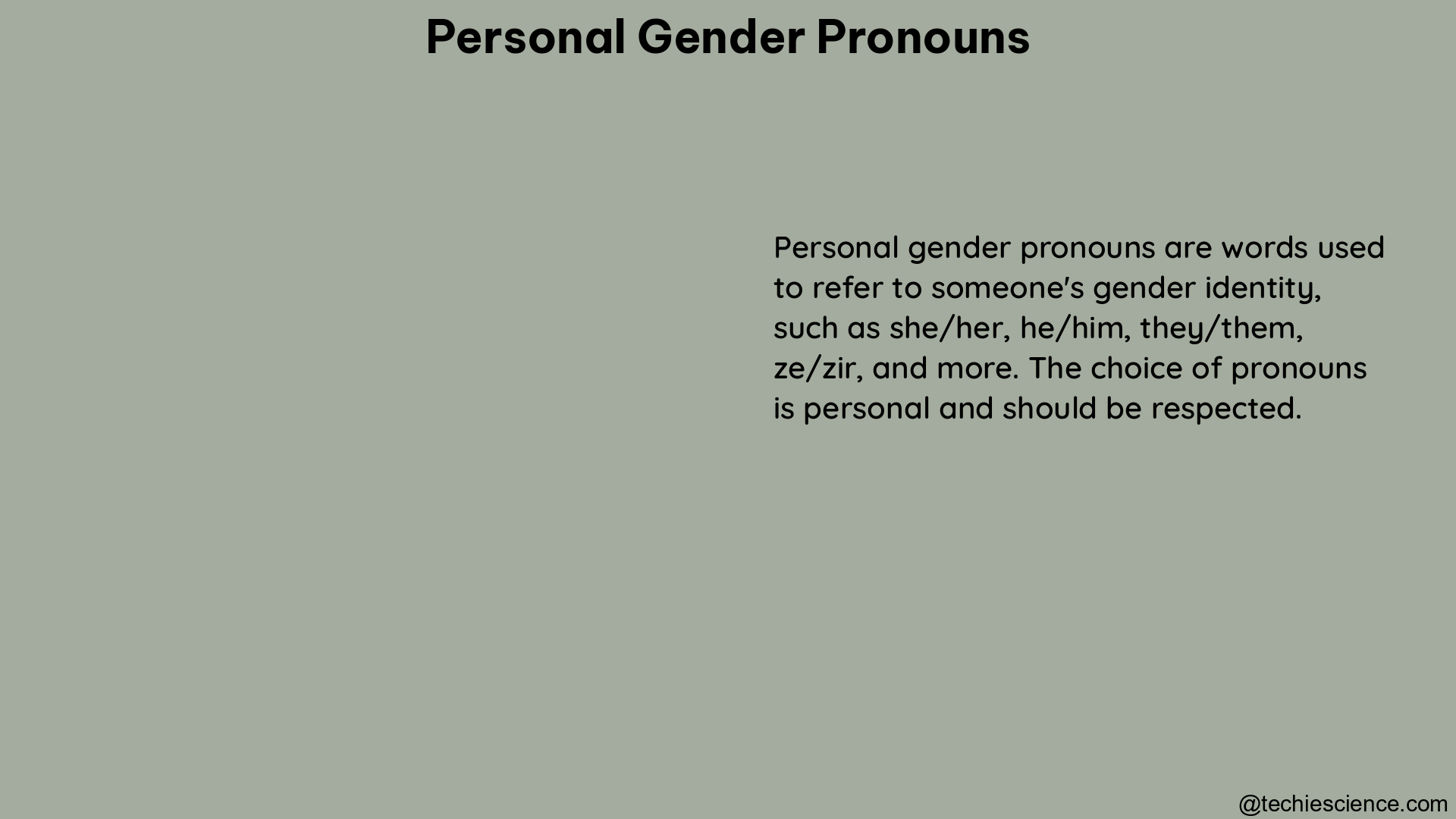Personal gender pronouns are an essential part of someone’s gender expression and identity. They are the words used to refer to a person in place of their name, and they can vary beyond the traditional “he/him” and “she/her” pronouns. Understanding and respecting personal gender pronouns is crucial for creating an inclusive and respectful environment.
Understanding Gender Pronouns
Types of Gender Pronouns
- Binary Pronouns:
- She/Her/Hers: These pronouns are typically used by individuals who identify as women or feminine.
-
He/Him/His: These pronouns are typically used by individuals who identify as men or masculine.
-
Nonbinary Pronouns:
- They/Them/Theirs: These gender-neutral pronouns can be used by individuals who identify as nonbinary, genderfluid, or outside the gender binary.
- Ze/Zir/Zirs: These are another set of gender-neutral pronouns that some nonbinary individuals use.
-
Ey/Em/Eirs: These are less common gender-neutral pronouns that some nonbinary individuals use.
-
Multiple Pronouns:
- Some individuals use multiple sets of pronouns, such as “they/she” or “he/they,” indicating that they are comfortable with either set being used.
Importance of Respecting Pronouns
-
Avoiding Misgendering: Using the correct pronouns for someone is essential to avoid misgendering, which can be deeply hurtful and disrespectful, especially for transgender and gender non-conforming individuals.
-
Inclusivity and Respect: Respecting someone’s pronouns shows that you acknowledge and respect their gender identity, which is an important aspect of their overall identity and expression.
-
Creating a Safe Environment: Normalizing the practice of sharing and using correct pronouns can help create a more inclusive and welcoming environment for people of all gender identities.
Practical Tips for Using Pronouns

Introducing Yourself with Pronouns
When introducing yourself, it’s a good practice to share your own pronouns. This can be done in various ways, such as:
- “Hi, my name is Alex, and my pronouns are they/them.”
- “Hello, I’m Samantha, and I use she/her pronouns.”
- “My name is Kai, and my pronouns are ze/zir.”
Asking for Someone’s Pronouns
When meeting someone new or interacting with someone you’re not familiar with, it’s polite to ask for their pronouns. Some examples of how to do this:
- “What pronouns do you use?”
- “How would you like me to refer to you?”
- “Can you remind me of your pronouns?”
Correcting Mistakes
If you accidentally use the wrong pronouns for someone, it’s important to correct yourself and apologize. This shows that you are committed to using the correct pronouns and respecting the person’s identity.
- “Sorry, I meant to say ‘they’ instead of ‘she.'”
- “My apologies, I should have used ‘he’ instead.”
Incorporating Pronouns into Everyday Language
To normalize the use of pronouns, it’s helpful to incorporate them into your everyday language, such as:
- “Everyone should bring their own lunch to the meeting.”
- “The student completed their assignment on time.”
- “The new employee introduced themself to the team.”
Nonbinary Pronouns in Practice
Using nonbinary pronouns, such as “they/them/theirs” or “ze/zir/zirs,” may require some practice, but it’s important to make the effort to use them correctly.
Examples of Nonbinary Pronoun Usage
- “Ze went to the store and bought zir a new shirt.”
- “Ey really enjoyed the movie and thought it was em’s favorite.”
- “The artist showcased their latest work at the gallery.”
Addressing Groups with Nonbinary Pronouns
When addressing a group that includes individuals who use nonbinary pronouns, it’s best to use gender-neutral language, such as:
- “Everyone, please remember to bring your own supplies to the workshop.”
- “Folks, let’s take a break and stretch our legs.”
- “Students, you’ll need to submit your assignments by the end of the week.”
Inclusive Language Practices
Using inclusive language goes beyond just respecting personal gender pronouns. It also involves avoiding gender-specific terms and using gender-neutral alternatives.
Examples of Inclusive Language
- Instead of “guys,” use “folks,” “everyone,” or “team.”
- Instead of “ladies and gentlemen,” use “distinguished guests” or “honored attendees.”
- Instead of “boyfriend/girlfriend,” use “partner” or “significant other.”
By incorporating these inclusive language practices, you can create a more welcoming and inclusive environment for people of all gender identities.
Conclusion
Personal gender pronouns are an essential part of someone’s identity and should be respected. By understanding the different types of pronouns, practicing their use, and incorporating inclusive language, you can contribute to creating a more inclusive and respectful environment for everyone.
References
- University of Wisconsin-Milwaukee. (n.d.). Gender Pronouns | LGBTQ+ Resource Center. Retrieved from https://uwm.edu/lgbtrc/support/gender-pronouns/
- North Dakota Department of Health. (n.d.). A Guide to Using Personal Pronouns. Retrieved from https://www.hhs.nd.gov/sites/www/files/documents/DOH%20Legacy/Pronouns.pdf
- University of California, Davis. (2024). Pronouns & Inclusive Language – LGBTQIA Resource Center. Retrieved from https://lgbtqia.ucdavis.edu/educated/pronouns-inclusive-language
Hi… I am Sowndharya Jagadeeswaran, a university rank holder in M.A. English Literature. I have also done my master’s in Business Administration. Inquisitive as I am, my interest in action-oriented research helped me publish research papers in reputed journals. Now, as a career, I am an instructor where I teach young and adorable students the intricate technicalities of Public Speaking and Creative Writing. I also enjoy writing articles on topics I specialize and research in.
You can connect with me through LinkedIn.-